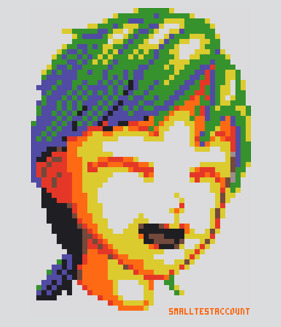I’m going to refer to them as chinese characters because it makes more sense. Of course this all applies to Kanji.
So I’ve been itching to make a game with chinese characters and I know many of you want Japan Kanji for your Japanese styled games. Kanji and Chinese aren’t new to pico-8. But almost every use of chinese characters are put into the sprite sheet. I think it’s obvious that won’t work for most people since you can’t use any other sprites or the map.
So I’ve been working on a horrible compression system to get vectors of radicals and work on combining radicals into hodgepodged characters. If you didn’t know, chinese characters are often made of smaller radicals (which usually function as their own characters too)
For example: 好 meaning “good”, “nice”, etc.. . The character is made of two smaller characters: 女 “woman” and 子 “child”. My goal is to make the radicals as vector shapes and combine them into various characters. I’ve gotten the radicals down to strings, with 0-9 letters representing cordinates which will need to be changed to base 64 by using the letters, glyphs, numbers, and two other symbols which I haven’t figured out but should be fine. Then I need to get a function to read some variable of where to put and size each radical. I think that when someone would want to use this system they shouldn’t have a respiratory of 2,000 to 8,000 characters and instead pick and grab some for their use.
So if you read my worthless plan I want to know what am I missing or what am I doing that is horrible? I will post a demo soon once I got the placement function down. If you ask me I got about half way with it all in about a day excluding adding the many characters and radicals which might just take forever. I should probably wait to post but I know something in my plan must be bad.
Edit: Here’s the Wikipedia article on radicals: https://en.m.wikipedia.org/wiki/Radical_(Chinese_characters)

It's always a good idea to see what's out there first, PB.
https://www.lexaloffle.com/bbs/?tid=28211
Minju, it sounds like you've got something interesting planned so - would definitely like to see it.

You know more about kanji than I do, but I was curious to see the data model of a kanji-capable LCD display and found this datasheet. Might be some inspiration for resolution and data size requirements. This one has a 8064 character set and 16x16 pixels per character. Maybe that's just easier if you have the space, or maybe at low resolution you need to hand-tailor the glyphs? It does seem interesting to try a vector representation that draws at two widths, but it might be challenging at 128x128 total screen size.
Best of luck!

@ddaaannn
The reason I’m going with vectors rather than rasters is because
-
Resizeability: Different uses need different font sizes. Educational programs may need big letters while an RPG may need smaller letters.
-
Fonts: If you want a different font all you need to do is remake all the radicals rather than the characters, and you can create different styles lines like Anti-Aliased, thick, wobbly, etc..
- Less work: You need to make each radical then mash them together, instead of making each by hand. As well, it works better for crowd sourcing, example: You can have a little website where you are given the pallete of radicals and you can put them together which is easier for people to understand and you don’t get handwriting issues where everyone draws each character differently.
I do want to clearing the ISO and native speakers recognize radicals as a part of chinese characters
[Please log in to post a comment]







